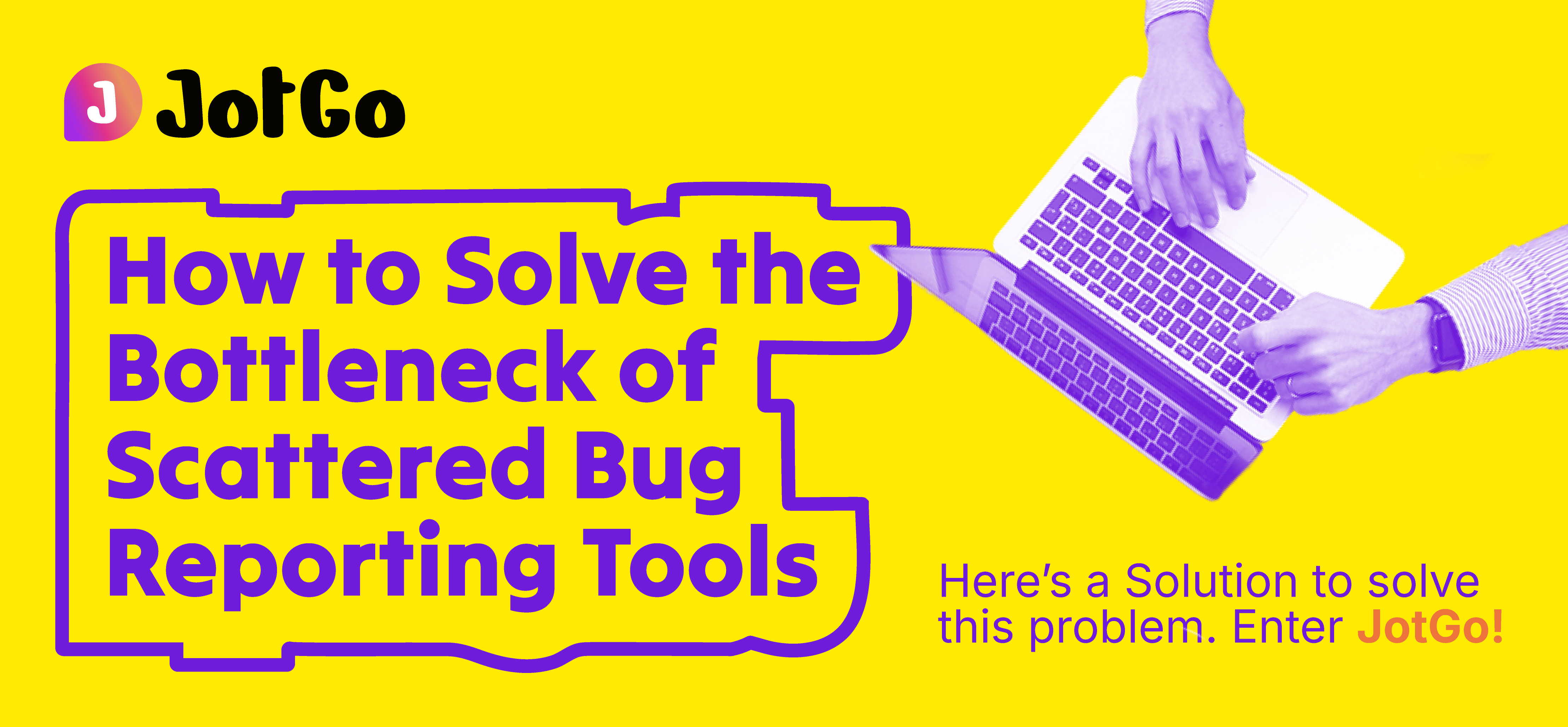How to Solve the Bottleneck of Scattered Bug Reporting Tools

Bugs happen. They’re a part of developing software but the challenge is in managing them. For QA teams, developers and project managers, clear communication around bugs is key. Yet, fragmented workflows with scattered bug reporting tools lead to lost information, wasted time and a whole lot of frustration.
If that sounds all too familiar, don’t worry—you’re not alone. But there is a better way. This article will explore how scattered bug reporting tools create bottlenecks, how JotGo solves the problem and the benefits of integrating your tools to streamline bug tracking.
Scattered Bug Reporting Tools
Lost Reports, Frustrated Teams
Imagine this scenario (and it’s not hard to): a bug is found during testing, logged into one tool, discussed in Slack and somewhere along the way the original report gets lost. Sound familiar? Fragmented workflows mean teams are juggling multiple tools—many of which don’t talk to each other.
Important details like the environment, steps to reproduce or even the actual bug report often fall through the cracks. The result? Endless follow ups, rework and delays.
Bottlenecks Slow Development
Without a process, resolving bugs becomes a labyrinth. What starts as a small glitch becomes a back and forth between QA testers and developers. The extra time spent searching for information or duplicating reports slows down development which is the last thing you need when you’re sprinting towards release deadlines.
Even worse, these inefficiencies affect the whole project. Progress comes to a grinding halt as team members struggle to align their tools and communication, creating bottlenecks that shouldn’t exist in the first place.
But what causes these bottlenecks? Ineffective, fragmented reporting systems.
Enter JotGo: Consolidate Bug Reports for Seamless Collaboration
No one likes managing multiple tools across multiple platforms. That’s where JotGo comes in—a game changer for bug management. JotGo consolidates bug reports and integrates with the tools you already use, so every detail is in one place.
Unified Bug Reporting in Action
Here’s how JotGo solves what other tools can’t:
- Centralized Reporting: JotGo is the single source of truth for all bug reports. No more jumping between Jira, Trello, Slack or email threads to find the latest notes.
- Full Integration with Existing Tools: Already invested in your team’s favorite tools like Jira or Slack? JotGo integrates with them so you can continue using the tools you use—just more efficiently.
- Automatic Detail Capturing: With JotGo, testers no longer have to explain every bug. It automatically captures crucial information like error logs, environment settings and screen recordings, saving time and reducing errors.
Real-Time Collaboration
Since JotGo centralizes your workflow, collaboration is seamless. Testers can report bugs from where they work, developers can view actionable details without backtracking and all teams are on the same page with clearly categorized updates.
No one is left out of the loop and bugs can be squashed quickly, saving everyone hours of clarification emails and status meetings.
How Integration Reduces Friction and Drives Productivity
Integration isn’t just nice to have; it’s necessary. By connecting all your tools into one smooth workflow, you eliminate unnecessary steps and bottlenecks. Here’s how it helps your team work faster and smarter with JotGo.
1. Automation to Save Time
Manual data entry invites mistakes and wastes time. JotGo automates the reporting process by pulling in relevant details automatically. Developers get everything they need, testers avoid repetitive tasks and the team keeps moving without delays.
2. Simplified Workflows
When bug capturing, tracking and communication happen in one ecosystem, teams can focus on solving problems not tracking them down. Instead of duplicating efforts across tools, integration means everyone works from one source of truth.
For example, if a bug is reported in JotGo, it can automatically push the issue into Jira or Trello. Updates sync across tools so no more ‘What tool did we log this bug in again?’ headaches.
3. Better Team Communication
Integration through JotGo means everyone—no matter their role—has access to the same information. Whether the QA team reports a bug or a developer resolves it, updates are visible to the entire team. This transparency reduces miscommunications.
4. Consistency and Accountability
When tools aren’t connected, workflows become inconsistent and tasks fall through the cracks. But with JotGo’s integration, every report, update and resolution stays in one system. Teams can track progress and accountability is built into the process.
Get More Done
Time saved on hunting bugs means more time solving problems. JotGo helps teams squash bugs faster so software gets better and deadlines are met without team morale taking a hit.
And better productivity isn’t just about speed. It’s also about reducing stress and increasing overall job satisfaction—a win for everyone.
Start streamlining bug reporting today
Scattered tools and lost reports shouldn’t hold your team back. With JotGo, bug reporting gets the clarity and efficiency it deserves.
Why juggle disconnected systems when one integrated platform can do it all? From auto-capturing bugs to syncing updates across tools, JotGo removes the friction so your team can focus on what they do best—building great software.
Get started today
Sign up for JotGo now!











